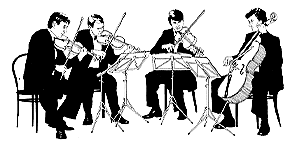Steven Ledbetter, BUPS
 Wolfgang Amadeus Mozart's brilliant Symphony No.35 in D major K.385, entitled "Haffner", because it was written for the Haffner family in Salzburg, was originally composed as a serenade. A serenade, or sometimes called a cassation, was a festive piece written for specific occasions and usually had the basic classical three movement structure to which were added marches and minuets along with other movements usually reserved for soloists. Mozart's original Haffner Serenade had five movements with two minuets. He kept the brilliant outer movements (and the sparkling key of D major, a favorite of his) that are characteristic of the serenade (Allegro con spirito and the Finale: Presto) and added a slow andante and formal minuet as middle movements to round out the traditional symphonic structure. It is one of Mozart's most exciting, beautiful, and justly popular works.
Wolfgang Amadeus Mozart's brilliant Symphony No.35 in D major K.385, entitled "Haffner", because it was written for the Haffner family in Salzburg, was originally composed as a serenade. A serenade, or sometimes called a cassation, was a festive piece written for specific occasions and usually had the basic classical three movement structure to which were added marches and minuets along with other movements usually reserved for soloists. Mozart's original Haffner Serenade had five movements with two minuets. He kept the brilliant outer movements (and the sparkling key of D major, a favorite of his) that are characteristic of the serenade (Allegro con spirito and the Finale: Presto) and added a slow andante and formal minuet as middle movements to round out the traditional symphonic structure. It is one of Mozart's most exciting, beautiful, and justly popular works.
Camille Saint-Saens was born October 9, 1835, in Paris and died December 16, 1921. During his long and extraordinary life he was part of a musical world that evolved from the heights of Romanticism to the modern musical world of Stravinsky and Schoenberg. He was a friend of Berlioz and Liszt, who described him as the finest organist in the world. Wagner admired his abilities as a pianist, and as a teacher his pupils included Gabriel Faure and Andre Messager.
Saint-Saens wrote works in all genres including symphonic poems, symphonies, and works for children (Carnaval des Animaux), as well as concertos for piano and cello. He had the most polished technique and his French musical language was imbued with a beautifully balanced, classical sense of form. All of these traits can be found in his "Fifth Piano Concerto" (1895), one of his finest works.
The first two symphonies of Johannes Brahms reveal an interesting study in contrasts. Brahms' first symphony, performed brilliantly by the Bilkent Symphony Orchestra (BASSO) during its fall schedule, is a gigantic work of the most serious nature and took the composer years to complete. On the other hand, his Symphony No. 2 in D major was completed in a matter of months in the summer of 1877 and reveals his tender, pastoral side. You will notice that the second theme of the first movement recalls his famous Lullaby. The work is in four movements: Allegro non Troppo (sonata form), Adagio (3-part song form), Allegretto grazioso (rondo form), and Allegro con spirito (sonata form). It received the most enthusiastic reception when it was first performed and remains one of Brahms' most popular works besides being one of his own personal favorites. (Due to an unexpected change in the BASSO schedule, we were not able to prepare BASSO notes for the concert on Tuesday, February 2.)
Program for Tuesday, February 2
Conductor Jean Fournet, violinist Anastasia Chebotarova.
Gabriel Pierne: Divertissement sur un theme pastorale.
Piyotr Ilyich Tschaykovski: Violin Concerto in D Major.
Richard Strauss: suit Rosenkavaleier, aria Tenore.
Faculty of Music and Performing Arts Auditorium, 9 p.m.
For more information and reservations, call 266-4382.








